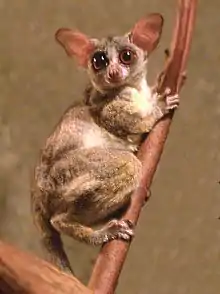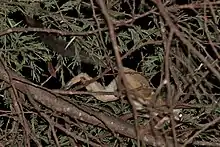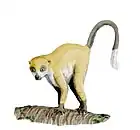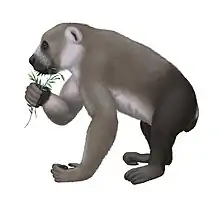Lesser bushbaby
Lesser bushbabies, or lesser galagos, are strepsirrhine primates of the genus Galago. They are classified, along with the other bushbaby and galago genera in the family Galagidae.[1] They are probably the most numerous primate in Africa, and can be found in every large forest on the continent, inhabiting forested areas, savannas, riverine bush and open woodlands.[2][3]
| Galago[1] | |
|---|---|
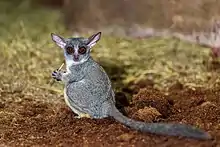 | |
| Senegal bushbaby (G. senegalensis) | |
| Scientific classification | |
| Domain: | Eukaryota |
| Kingdom: | Animalia |
| Phylum: | Chordata |
| Class: | Mammalia |
| Order: | Primates |
| Suborder: | Strepsirrhini |
| Family: | Galagidae |
| Genus: | Galago É. Geoffroy, 1796 |
| Type species | |
| Galago senegalensis É. Geoffroy, 1796 | |
| Species | |
|
Galago gallarum | |
They mark their territory by urinating on their hands and leaving traces on the trees they climb across, and they follow these detectable paths through the trees night after night. Males will also urinate on females to mark them. They are related to lorises, and have similar behavior and anatomy. They are much faster, however, and typically hunt by speed rather than by stealth.[2] Primitive bushbabies are thought to have been the ancestors of all lemurs.[2]
Appearance
Lesser bushbabies are small, woolly primates with long tails and oversized, naked ears. Different species are sometimes indistinguishable even when compared side by side.[4] Additionally, there is often notable variation in coloration and body size even within species and populations.[5] Their coat varies across body regions as well as between species, typically ranging from black, brown, and grey to white, with many showing a greenish, reddish, and orangeish tint to the sides and limbs. Some species have a nasal strip while others have distinct dark rings around the eyes.[4]
Their neck is very flexible, so that the head can turn 180 degrees,[6] which gives them a broad field of vision which is helpful in locating prey; they also have highly mobile ears that allow them to track insects as they hunt. Round flat pads on their fingertips, between their fingers, and on their palms at the base of their thumbs enable them to firmly grip the branches.[7] They also have pointed, keeled nails that give them stability as they cling to smooth tree surfaces and reach for insects into crevices, using their rough narrow tongue.[3]
Distribution and habitat
Lesser bushbabies are distributed through most of Sub-Saharan Africa, ranging from Senegal east to Somalia and down to South Africa (excepting its southern extreme) and are present in almost every country in between. However, there are great differences in their extent and distribution by species. G. senegalensis is the most widespread species, extending from Senegal in the west across central Africa to eastern Africa. G. moholi has a broad distribution over much of southern Africa. G. gallarum has more restricted distributions in eastern Africa, and G. matschiei is restricted to Uganda.[8]
Lesser bushbabies are found in a variety of habitats, such as woodland, bushland, savanna, montane forest, riverine habitats; favouring trees with little grass around them.[9]
Diet
Bushbabies generally consume three types of food in various proportions and combinations: animal prey, fruit, and gum. Although their diet consists mainly on small invertebrates (mostly insects), some species also eat frogs and possibly other small animals.[4]
Behavior
Galagos are tree dwelling primates and are capable of leaping significant distances, up to and sometimes greater than 2.5 metres (8 ft 2 in),[10] using flattened disks on their feet and hands as a way of grasping branches.[11] However they do walk on the ground sometimes, either bipedally or on all fours.[11]
Galagos are nocturnal animals, foraging at night and sleeping in trees during the day. Adults are mainly solitary and maintain social contact mainly through vocal communication. There are up to 18 distinct calls, used mainly for territorial advertisement and long-distance spacing.[12] All these calls are part of three categories, defensive and aggressive, social contact, and annunciatory. They also have very highly developed hearing.[13][14]
Bushbabies are solitary foragers, however they do meet up at night in groups. Some species, such as G. moholi, can be found sleeping in groups of 2 to 7 during the day.[15] These groups are typically composed of a female and several of her young. At night the groups separate to forage independently. Males are mostly aggressive to each other; dominant males are the only ones that defend territories and are often the largest and most aggressive.[15]
Breeding
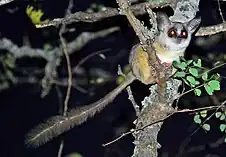
Lesser bushbabies usually give birth during the rainy season. The offspring are usually twins.[16] After the birth there is usually a second period of heat. A female’s gestation period is between 111–142 days and will usually consist of the female mating with up to 6 different males.[11][17]
Lesser bushbaby mothers initially shelter their offspring in a nest or tree hollow, later on concealing the infants in foliage while they forage at night.[16]
Taxonomy
| Common name | Scientific name and subspecies | Range | Size and ecology | IUCN status and estimated population |
|---|---|---|---|---|
| Dusky bushbaby | G. matschiei Liburnau, 1917 |
Central Africa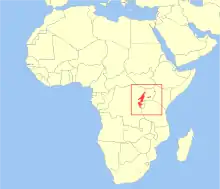 |
Size: 14–19 cm (6–7 in) long, plus 24–28 cm (9–11 in) tail[18] Habitat: Forest[19] Diet: Insects, fruit, flowers, and gum[18] |
LC
|
| Mohol bushbaby
|
G. moholi Smith, 1836 |
Central and southern Africa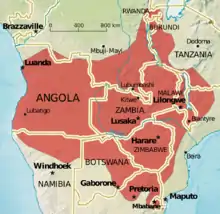 |
Size: 14–17 cm (6–7 in) long, plus 11–28 cm (4–11 in) tail[20] Habitat: Savanna[21] Diet: Arthropods, as well as tree gum and resin[20] |
LC
|
| Senegal bushbaby
|
G. senegalensis É Geoffroy, 1796 Four subspecies
|
Equatorial Africa (possible additional range in red)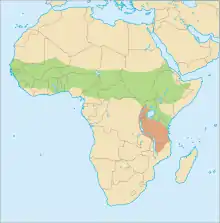 |
Size: 13–21 cm (5–8 in) long, plus 19–30 cm (7–12 in) tail[22] Habitat: Forest and savanna[23] Diet: Insects, as well as small birds, eggs, fruits, seeds, flowers, and tree gum[24] |
LC
|
| Somali bushbaby
|
G. gallarum Thomas, 1901 |
Eastern Africa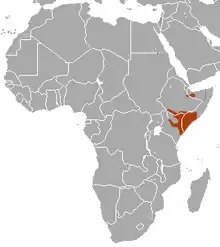 |
Size: 13–20 cm (5–8 in) long, plus 20–30 cm (8–12 in) tail[22] Habitat: Savanna[25] Diet: Gum and invertebrates[22] |
LC
|
References
- Groves, C. P. (2005). "Genus Galago". In Wilson, D. E.; Reeder, D. M (eds.). Mammal Species of the World: A Taxonomic and Geographic Reference (3rd ed.). Johns Hopkins University Press. pp. 124–126. ISBN 978-0-8018-8221-0. OCLC 62265494.
- David Attenborough, Life of Mammals, Episode 8: Life in the Trees. BBC Warner, 2003.
- Abrams, Sylvie (November 2016). "Lesser Galago". New England Primate Conservatory. Archived from the original on 2020-10-26. Retrieved 2020-10-23.
- "Lesser bushbaby". WNPRC.
- Ambrose, Lesley (January 2003). "Three acoustic forms of Allen's galagos (Primates; Galagonidae) in the Central African region". Primates. 44 (1): 25–39. doi:10.1007/s10329-002-0004-x. ISSN 0032-8332. PMID 12548332. S2CID 23422588.
- Grzimek's encyclopedia of mammals (English language ed.). New York: McGraw-Hill Publishing Company. 1990. ISBN 9780079095084.
- Sleeper, Barbara (1997). Primates : the amazing world of lemurs, monkeys, and apes. San Francisco: Chronicle Books. ISBN 9780811814348.
- Fleagle, John G. (2013). "Chapter 4 - The Prosimians: Lemurs, Lorises, Galagos and Tarsiers". Primate Adaptation and Evolution (Third ed.). San Diego: Academic Press. pp. 57–88. ISBN 978-0-12-378632-6.
- Schütze, Heike (12 June 2013). Field guide to the mammals of the Kruger National Park. Cape Town. ISBN 9781431701902.
{{cite book}}: CS1 maint: location missing publisher (link) - Butynski, Thomas M.; de Jong, Yvonne A. (January 2004). "Natural History Of The Somali Lesser Galago (Galago gallarum)". Journal of East African Natural History. 93 (1): 23–38. doi:10.2982/0012-8317(2004)93[23:NHOTSL]2.0.CO;2.
- "Lesser Bushbaby". Siyabona Africa. Retrieved 10 March 2012.
- Schneiderová, Irena; Singh, Navinder J.; Baklová, Aneta; Smetanová, Milena; Gomis, Nicolas Benty; Lhota, Stanislav (March 2020). "Northern lesser galagos (Galago senegalensis) increase the production of loud calls before and at dawn". Primates. 61 (2): 331–338. doi:10.1007/s10329-019-00784-3. PMID 31903513. S2CID 209843888.
- An Atlas and source book of the lesser bushbaby, Galago senegalensis. Boca Raton, Fla.: CRC Press. 1981. ISBN 9780849363207.
- Bearder, Simon (1995). "Calls of the Wild". Natural History. 104: 48–57.
- Poynter, Therien. "Galago moholi (South African galago)". Animal Diversity Web.
- Dixson, Alan F. (26 January 2012). Primate Sexuality: Comparative Studies of the Prosimians, Monkeys, Apes, and Humans. Oxford University Press. p. 137. ISBN 978-0-19-150342-9. Retrieved 28 April 2013.
- Fitterer, Carolynn. "Galago gabonensis (Gabon bushbaby)". Animal Diversity Web.
- Kingdon et al., p. 440
- Butynski, T. M.; de Jong, Y. A. (2019). "Galago matschiei". IUCN Red List of Threatened Species. 2019: e.T8787A17963414. doi:10.2305/IUCN.UK.2019-3.RLTS.T8787A17963414.en.
- Poynter, Therien (2009). "Galago moholi". Animal Diversity Web. University of Michigan. Retrieved June 25, 2023.
- Bearder, S.; Svensson, M.; Butynski, T. M.; de Jong, Y. A. (2021). "Galago moholi". IUCN Red List of Threatened Species. 2021: e.T8788A206563837. doi:10.2305/IUCN.UK.2021-3.RLTS.T8788A206563837.en.
- Kingdon, ch. Galagos
- de Jong, Y. A.; Butynski, T. M.; Svensson, M.; Perkin, A. (2019). "Galago senegalensis". IUCN Red List of Threatened Species. 2019: e.T8789A17963505. doi:10.2305/IUCN.UK.2019-3.RLTS.T8789A17963505.en.
- Ballenger, Liz (2001). "Galago senegalensis". Animal Diversity Web. University of Michigan. Retrieved June 25, 2023.
- de Jong, Y. A.; Butynski, T. M. (2019). "Galago gallarum". IUCN Red List of Threatened Species. 2019: e.T8786A17963185. doi:10.2305/IUCN.UK.2019-3.RLTS.T8786A17963185.en.
External links
 Data related to Galago (Lesser bushbaby) at Wikispecies
Data related to Galago (Lesser bushbaby) at Wikispecies- Primate Info Net Galago Factsheet
- "Galago senegalensis". Retrieved 8 March 2012.
%252C_crop.jpg.webp)
